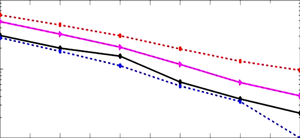Channel estimation scheme for MIMO communication using generalized Cholesky decomposition and back substitution methods
DOI:
https://doi.org/10.3103/S0735272721060054Keywords:
MIMO, Semi-blind channel estimation, LS, MAP, orthogonal pilots, QR decompositionAbstract
In this article, a novel semi-blind channel estimation scheme for Multiple-Input Multiple-Output (MIMO) communication system is studied and implemented for quasi-static Rayleigh fading channel, in which channel matrix H remains relatively constant throughout the block. Channel matrix H can be decomposed as a rotation matrix Q and down triangular matrix R. The triangular matrix R is estimated blindly using the QR-decomposition based Generalized Cholesky Decomposition method (GCD) of output covariance matrix, which exploits Independent Component Analysis (ICA) based blind source separation stochastic method, and Q is estimated from the orthogonal pilot symbols using QR-based novel approach to minimize the cost function. In this novel approach, orthogonal pilots can be decomposed as a deterministic Hermitian matrix and the upper triangular matrix using the QR-decomposition, and finally matrix Q can be estimated by using the back substitution method, which is presented in this paper. Simulations are demonstrated using the Alamouti space-time coded 2 transmitter antennas and different combinations of 2 and 6 receiver antennas to showcase the performance of the novel scheme as compared to the conventional Least Squares (LS) and Maximum a posterior (MAP) estimation schemes using the BPSK data modulation scheme. The results indicate that the novel scheme outperforms the other schemes and shows a considerably better result in terms of bit error rate (BER). Hence, the novel scheme is quite useful for solving a complex problem of semi-blind MIMO channel estimation by using the QR matrix decomposition technique. Further error analysis is presented in terms of the error covariance matrix by considering the noise for non-zero error case (practical case) as compared to zero-error case.
References
- J. Proakis, M. Salehi, Digital Communications, 5th ed. New York: McGraw-Hill Science/Engineering/Math, 2007, uri: http://www.amazon.com/Digital-Communications-Edition-John-Proakis/dp/0072957166.
- E. Nayebi, B. D. Rao, “Semi-blind channel estimation for multiuser massive MIMO systems,” IEEE Trans. Signal Process., vol. 66, no. 2, pp. 540–553, 2018, doi: https://doi.org/10.1109/TSP.2017.2771725.
- H. Jie, “Semi-blind channel estimation of MIMO-OFDM systems based on improved PSO-Hopfield neural network,” in Proceedings of the 2nd International Conference on Intelligent Systems, Metaheuristics & Swarm Intelligence - ISMSI ’18, 2018, pp. 153–157, doi: https://doi.org/10.1145/3206185.3219779.
- T. Peken, G. Vanhoy, T. Bose, “Blind channel estimation for massive MIMO,” Analog Integr. Circuits Signal Process., vol. 91, no. 2, pp. 257–266, 2017, doi: https://doi.org/10.1007/s10470-017-0943-1.
- A. Jagannatham, B. D. Rao, “A semi-blind technique for MIMO channel matrix estimation,” in 2003 4th IEEE Workshop on Signal Processing Advances in Wireless Communications - SPAWC 2003 (IEEE Cat. No.03EX689), 2004, vol. 2004-Janua, pp. 304–308, doi: https://doi.org/10.1109/SPAWC.2003.1318971.
- X. Liu, F. Wang, M. E. Bialkowski, “Investigation into a whitening-rotation-based semi-blind MIMO channel estimation for correlated channels,” in 2008 2nd International Conference on Signal Processing and Communication Systems, 2008, pp. 1–4, doi: https://doi.org/10.1109/ICSPCS.2008.4813728.
- Q. Zhang, W.-P. Zhu, Q. Meng, “Whitening-rotation-based semi-blind estimation of MIMO FIR channels,” in 2009 International Conference on Wireless Communications & Signal Processing, 2009, pp. 1–4, doi: https://doi.org/10.1109/WCSP.2009.5371541.
- F. Wan, W.-P. Zhu, M. N. S. Swamy, “Perturbation analysis of whitening-rotation-based semi-blind MIMO channel estimation,” in 2009 52nd IEEE International Midwest Symposium on Circuits and Systems, 2009, pp. 240–243, doi: https://doi.org/10.1109/MWSCAS.2009.5236109.
- E. V. Rogozhnikov, G. P. Babur, “Method for enhancing the accuracy of frequency offset estimation in OFDM modulation based communication systems,” Radioelectron. Commun. Syst., vol. 61, no. 8, pp. 342–349, 2018, doi: https://doi.org/10.3103/S0735272718080022.
- S. B. Patel, J. Bhalani, Y. N. Trivedi, “Performance of full rate non-orthogonal STBC in spatially correlated MIMO systems,” Radioelectron. Commun. Syst., vol. 63, no. 2, pp. 88–95, 2020, doi: https://doi.org/10.3103/S0735272720020041.
- D. V. Chauhan, J. K. Bhalani, Y. N. Trivedi, “Improvement of symbol error rate performance in spatial multiplexing systems using transmit antenna selection,” Radioelectron. Commun. Syst., vol. 62, no. 12, pp. 642–648, 2019, doi: https://doi.org/10.3103/S0735272719120045.
- K. C. Jomon, S. Prasanth, “Joint channel estimation and data detection in MIMO-OFDM using distributed compressive sensing,” Radioelectron. Commun. Syst., vol. 60, no. 2, pp. 80–87, 2017, doi: https://doi.org/10.3103/S0735272717020029.


